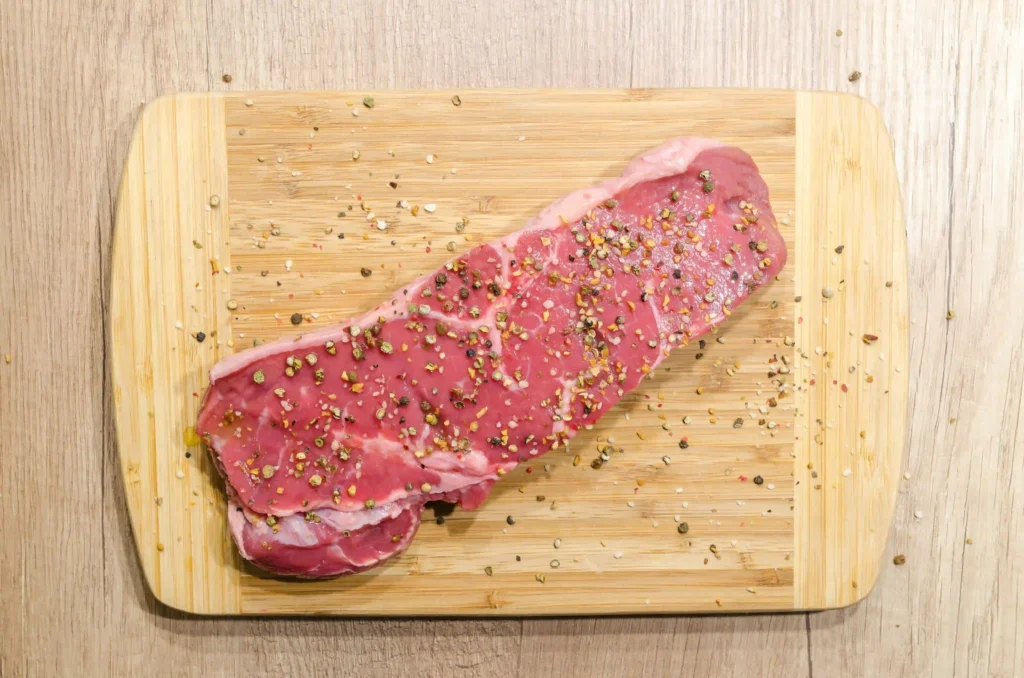Introduction

The amounts eaten need to be managed when consuming meat products. Eating a portion size ensures that you don’t over feed your body with substances such as calories or fats that might be unbeneficial to your body. Now let’s consider what is really the optimal place for a piece of meat on a plate.
Table of Contents
How Much Meat Should You Eat Per Meal?
Recommended portions of meat per serving are 3-to-4-ounce portions, the size of a standard deck of cards.
Consuming 3–4-ounce servings of meat per meal will allow you to get the needed protein without having to eat more calories or saturated fat than necessary. This portion size is within the portion size guidelines of the latest diet principles recommended for a balanced diet. It also helps avoid over intake of cholesterol and sodium; nutrients associated with diseases such as heart diseases. A deck of cards or the palm of one’s hand gives a perfect example of portion sizes. Accompanied by vegetables or whole grain, it forms a healthy meal. For example, for those wanting low carbs, high protein, athletes or anyone with a specific dietary need, changes may be required. Best practices of consuming meat should be moderate and free from monotony in order to create a healthy lifestyle for the consumer.
How Much Meat Should Adults Eat in One Sitting?
The recommended portions of cooked meat for adults are 3-6 ounces per serving depending in the recreational physical activity level or dietary requirement.
A suggested amount of meat per serving normally vary from 3 to 6 ounces depending on some factors and serving portion sizes. The sedentary man may need only 3 ounces while the sedentary woman can get by with this amount, though, active people will need probably 6 ounces for tissue repair and energy. Consuming large amounts of meat are capable to cause higher number of calories and increased levels of fat hence causing the situation of overweight or cardiovascular diseases. This means that portion control assists in approximating the gains from protein without overfeeding your body. Just as you can use a palm or a deck of cards to determine the portion size, you can estimate servings. Adding fiber containing vegetables and whole grains to the meat improves the nutrition value of the meal offering satisfaction.
Does Meat Serving Size Vary by Type (Beef, Chicken, Pork)?
Yes, different steaks have different serving portions, this is in the serving sizes table above. Originally, lean meats such as chicken have comparatively bigger recommended portion sizes as compared to fats which are beef or pork.
In terms of portion size sizes, the type of meat differs most dramatically. Chicken and turkey, as the leaner meats, can be portioned out a bit larger and servings are typically between 4-5 ounces. Nevertheless, ground beef or pork, which are higher in saturated fat, should not be taken more than 3 ounces for each meal. This division makes it easy in achieving the recommended proportions of food that is good for the heart. Also, the preparation techniques affect the quality and quantity of the nutrients—the grilling or baking maintains nutrient content and limits added oil. This is also true since one has to include lean meat, fatty meat and avoid having them frequently in equal proportions. For those searching for other sources, there are plant proteins to either supplement or substitute meat within an individual’s nutritional plan and environmental conservation.
How Many Ounces of Meat Should You Eat for Protein Needs?
Usually, 3-5 ounces of meat per meal will contain between 20- 35 grams of protein which is sufficient for most adult population.
Proteins are macro nutrients important for body muscles’ rebuilding and fortification of the immune system. Food protein requirements vary with age and sex; the recommended daily protein intake per kilogram body weight for most adults lie between 0.8g. This is approximately 55 grams of protein if scaled per day for a 150 pounds individual. Essentially, a 3-5 ounce serving of a lean meat, stands to afford about 20-35 grams of a high-quality protein, deemed to meet this requirement. More slender types of foods such as chicken or fish are ideal when it comes to the use of protein because they offer corresponding results without extra fats or calories. In the cases of those people whose need for proteins is higher – for example, athletes or people, who have recently suffered from an illness, it is possible to add more servings or foods with plant proteins. Proportionality of portions helps you gain the value from it with no added excess of meats.
What Happens If You Eat Too Much Meat in One Meal?

Intake more meat products within one meal since they cause bloating, indigestion and may lead to a staining your digestive system since they contain many calories.
Consequently, taking large quantities of meats at once results to some stomach upsets this is because proteins and fats which are common in meat take time to digest. Portion size may also become an issue since it could lead to over consumption of calorie and saturated fat hence fame and cardiovascular diseases. Also, it was established that body utilization of proteins is impaired when they are ingested in large quantities within the body system and turns out to be worthless since it lacks any utilization value. Meats when eaten with vegetables and other sources of fiber makes it easy for the body’s digestive system and the nutrients in the meat to be properly absorbed. Moderation gives the body all the positive aspects of taking beef without the negative side effects of unhealthiness.
Can Eating Large Portions of Meat Affect Digestion?
Yes, eating lots of meat will certainly make digestion process slow down consequently you are likely to experience problems of bloated tummy, gases or even constipation if you are not a fan of fibers.
Meat contains lots of proteins and fats that take time and energy to be digested by the body’s digestive system. Overindulgence can cause remedies to become a problem as they saturate the stomach and cause such as symptoms as indigestion, heartburn or slow digestion. Especially if it is a part of fattier meats or if meals don’t contain vegetables or grains, high amounts of fat will be absorbed. Soluble more slowly through the digestive tract helping to prevent constipation and to aid with digestion and absorption of nutrients. Overconsumption of meat also limits the hormone’s availability to the lower abdomen, which discourages digestion and acidity. To overcome them, portions of meats down and incorporate a wide range of whole foods in the meal. Another square that influences digestive health is hydration and also exercising.
How Does Meat Portion Size Fit Into a Balanced Diet?
The recommended servings of meat are small, 3-4 ounces per portion, thus when taken with vegetables whole grains and healthy fats do not pose a threat but instead are an enriching part of a perfect diet.
Using the right portions of meat in your meals means you are taking your protein and nutrients in without overdosing on calories or fats. Meat is rich in iron, zinc, and the B vitamins; however, regular consumption of meat raises the levels of both saturated fats, and cholesterol. Moderation of the portions of meat intake, with other food groups such as vegetable, beans and whole grain, forms a well balanced, energy providing and easily digestible plate. Substitute one serving of meat with beans, lentils, or tofu for that is more than just the environmental shifts, it is the physical body that requires a supply of beneficial nutrients to assist the heart and arteries. However, all these positive effects need to be gained through portion control since consuming considerable quantities of meat is dangerous.
How Much Meat Is Safe to Eat Daily According to Experts?
It is suggested that each person should intake 3 – 6 ounces of meat per day depending on their calorific intake or requirements for proteins.
Public health groups recommend that daily consumption of meat should be moderate to moderate-high, which should be approximately 3-6 ounces—a one- or two-serving size. This amount provides enough protein but at the same time help to control the levels of saturated fat and calorie that are dangerous for cardiovascular and metabolic diseases. The type of meat also counts —agri-foods or chicken and fish are healthier compared to processed or fatty meat products. The portions of each food should relate several factors like age, activity level and one’s dietary goals. Adopting a variety of meat products with plant foods such as beans and nuts also enhances a healthy diet and cuts the environmental costs. Moderation and making right choices once in a while to uphold health is very central once we consider taking meat.
Should Meat Serving Size Differ for Children and Adults?
Indeed, the child will need a smaller portion of the meat than an adult because children will need 1 to two oz of meat per meal.
As to children’s requirements for energy and protein, it is significantly lower than the adult one due to ages, weights and activity. In the case of younger children, it appears that the requirement of 1 to 2 ounce serving of meat per meal is adequate. It goes on to state that adults need between 3 to 6 ounces of protein per meal in order to maintain muscle mass and energy. The type of meat and preparation method are also important as children need lean, processed diet. The ability to order small portions guarantees the children eat healthy while leaving other healthy foods such as fruits, vegetables, and whole grains.
How Does Cooking Method Impact Meat Serving Size?
Different means of preparation such as grilling or baking is healthier than frying and breading whereby, calories contained in meats diminish portion sizes, reducing portions contained in meats.
Different preparations of meat affect both its quality nutrients wise and the appropriate portion size to be consumed. Meats Soaking and grilling, baking, or steaming helps keep the nutrients in as well as cutting on the additional fats making the portion compact and easily digestible. Breading, frying, using thick gravies or sautéing, adds fats and calories to foods so portion control becomes important in a mass distance meal plan. Cooking also helps us in expelling a lot of water from the muscle fibers thus the weight and size of many muscle cuts reduces; a 4-ounce portion may reduce to approximately 3 ounces when it is cooked. Replacing regular meat with lean meats and preparing it using healthy means help in portioning and provide nutrients necessary for the body from meats in appropriate calories and unhealthy fats.
Is It Better to Eat Lean Meats in Smaller Portions?

Yes, small portions of lean meats are far much healthier and contain less fat than other large portions of regular meat containing lots of fats.
Fish is also good but controlled portions of chicken breast, turkey and even pork and beef when trimmed of excessive fats are very good sources of protein with low saturated fats. Such should be divided into smaller proportions, which are normally a portion that occupies the palm of the hand, about 3 to 4 ounces in a meal so as to form a well-balanced nutrition without going out of track as far as calorie and fatty content is concerned. Less food portions also helps ease digestion, and also help avoid feeling uncomfortable after taking too much food. Combining the lean meats with fiber rich accompaniments such as vegetables and whole grain improves evening meal homeostasis and health profiles. It also comes in many forms of food, and some of them are good for grilling or steaming which does not reduce nutrient content. The quality and portion control taste permits lean meat products in the dieting process.
Can Eating Too Little Meat Lead to Nutritional Deficiencies?
Of course, it is possible to experience protein, iron, B12, and zinc deficiency because you eat very little meat.
Protein, iron-heme, vitamin B12 and vitamin zinc found in meat all play an important role in providing the body energy, supporting muscular actions and boosting immunity. Lack of meat or other protein products may cause such effects as tiredness, anemia, and a lowered immune level. One of the fat soluble vitamins, Vitamin B12 derived from animal foods, is fundamental to nerves and DNA replication and their deficiency leads to neurological diseases. Some of these nutrients can be obtained from plant sources but such a diet may take a lot of planning and supplementation. Eating moderate amounts of lean meats or plant based foods such as beans, lentils and foods fortified with these nutrients ensures that you do not lack any nutrient in your body.
How Do Dietary Guidelines Influence Meat Consumption Per Meal?
Current nutritional recommendations suggest that 3 to 6 ounces of meat should be consumed at a meal, and this amount should be combined with plant food to be healthy.
As mentioned before, current national and international dietary guidelines stress moderate meat eating that efficiently sustains essential nutrients without their surfeit. For instance, the USDA recommends eating from a list of protein foods and avoiding red and processed meats as they increase chances of diseases including heart diseases. These guidelines also recommend poultry- products such as chicken, turkey and fish that have lower saturated fats content. The portion size, normally 3 to 6 ounces per meal, serves the required amount of proteins in a day, and can be eaten along with other food groups such as fruits, vegetables and whole grains. According to these guidelines, people get all the advantages associated with meat consumption, while avoiding such drawbacks as the elevated risks of various diseases that occur if consuming meat in large quantities or consuming it too often.
What Tools Can Help Measure the Right Meat Portion Size?
Measuring spoon, kitchen scale and serving utensils and other aids such as a picture showing a standard portion size as the size of the person’s hand or a deck of cards can help in portion control.
Proper portioning of meat entails a proper degree of portioning and this greatly hampers over consumption of meat-based meals. Kitchen scale is the most accurate and weighing an amount of meat portions to fit the dietary recommendations (3-6¼ oz per meal) can be easily done. Dividing plates into sections of protein, vegetables, and grains also help the user to know when they are taking small proportions of the foods they need. For easy and better understanding and as a quick aid when determining portions, sizes are easily explained – one serving is as big as a deck of cards or your palm. Furthermore, apps and websites give the help of meal planning according to the diet requirements. These tools assist you in eating proper serving sizes and hence control the amount of protein that you consume with out going over calorie or fat limits.
Conclusion
It is important to show what part of meals should be constituted by meat in order to have balanced meals, which in turn have positive effects to peoples’ health. Alimentary requirements depend on age, level of activity, and specific goals but the main universal principle is moderation. Thus, portion control or portion control aids, especially the widely recommended 3-6 ounce per portion, when combined with other nutrient-dense foods, will ascertain that you get your preferred nutrients without the excess you would otherwise consume from larger portions of meats. Measuring spoons and cups, as well as kitchen weighing scales and portion control plates, help avoid over portions. Whether you are consuming lean meats or five percent occasional temptation, you are healthier and beautifully ripped, digest better and are less likely to fall victim to the effects of overindulgence of the product. Let me stress once more that the bulk of our diet should include lean meats as a part of a balanced healthy diet.